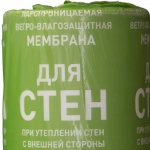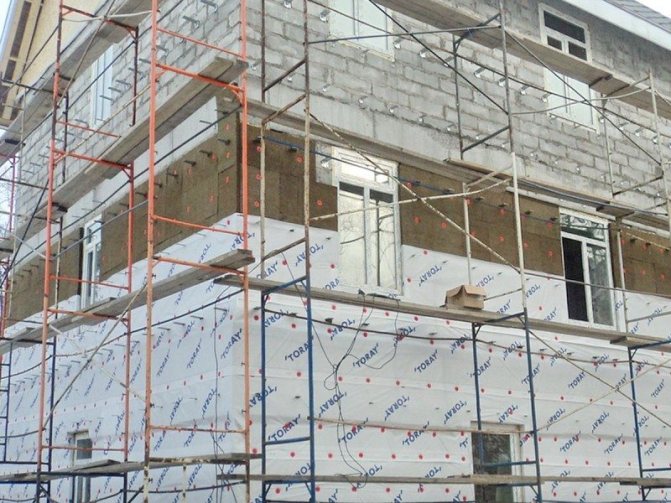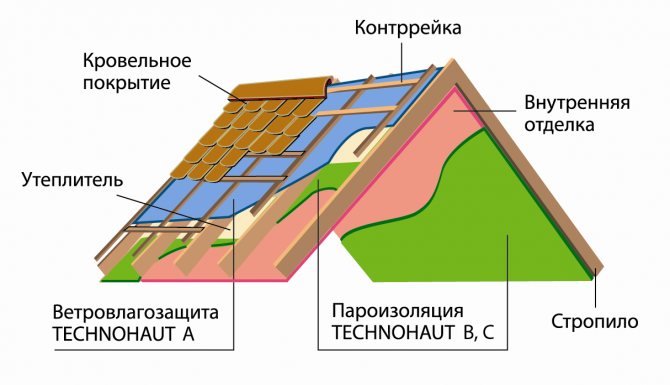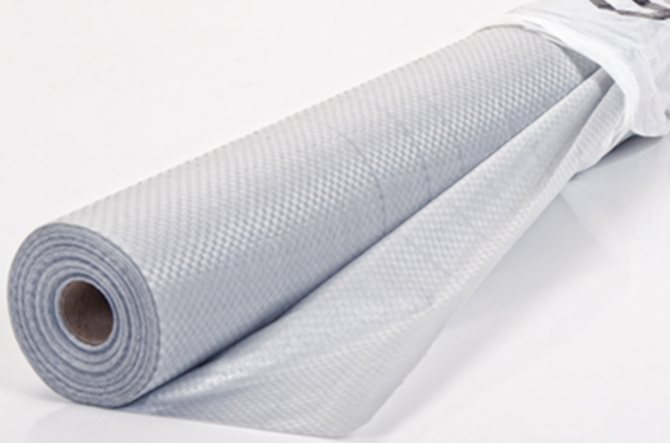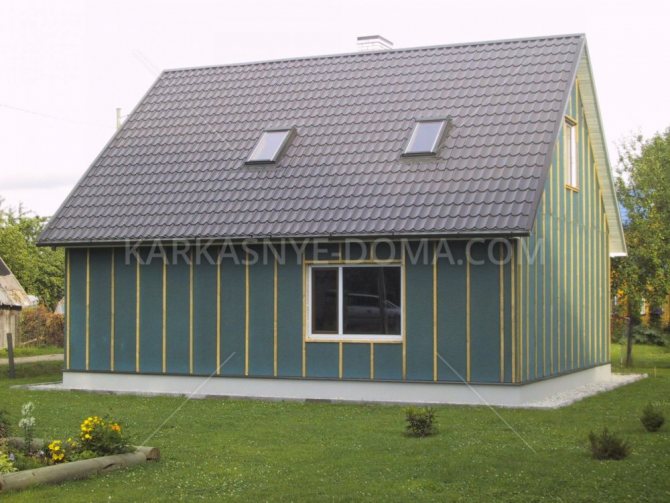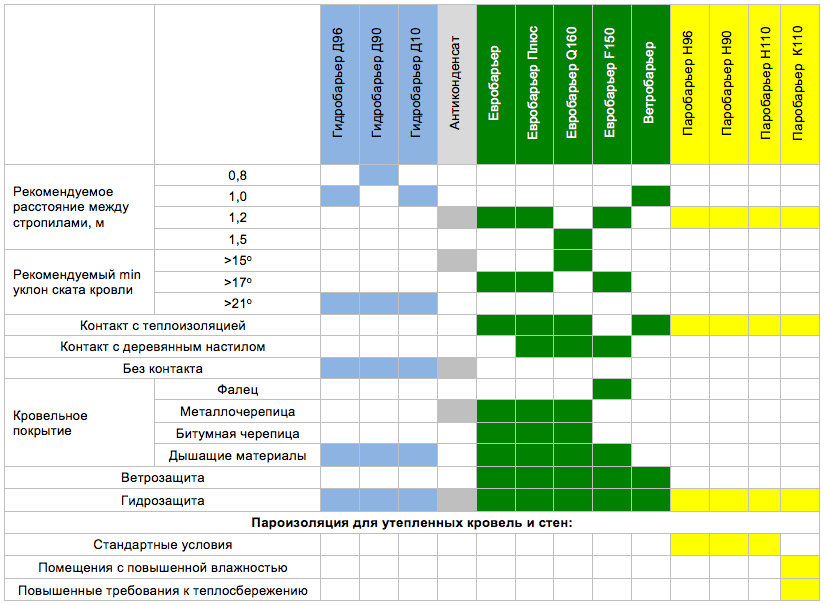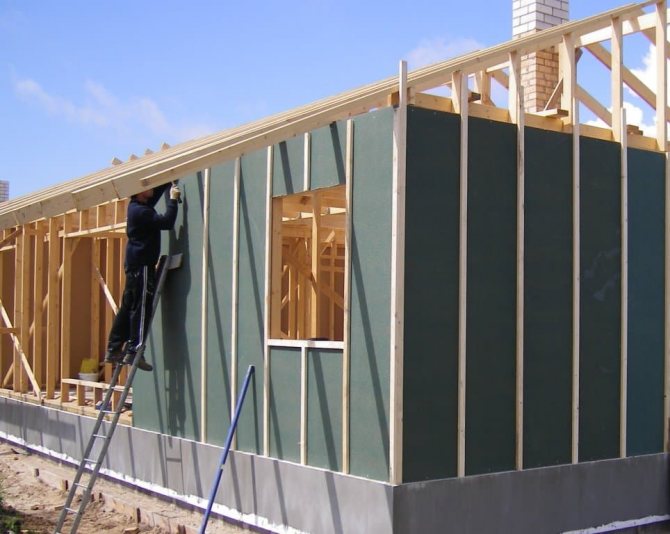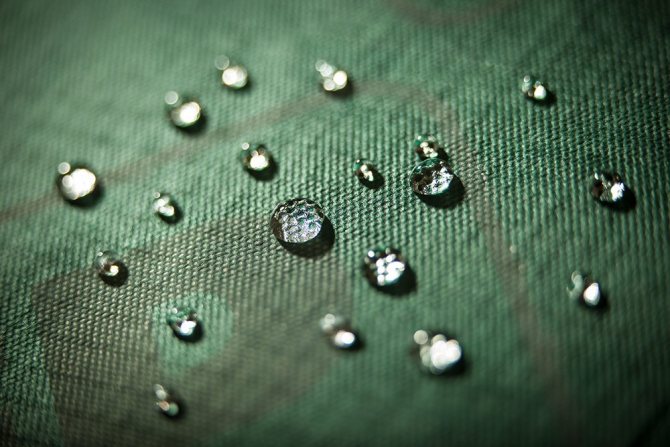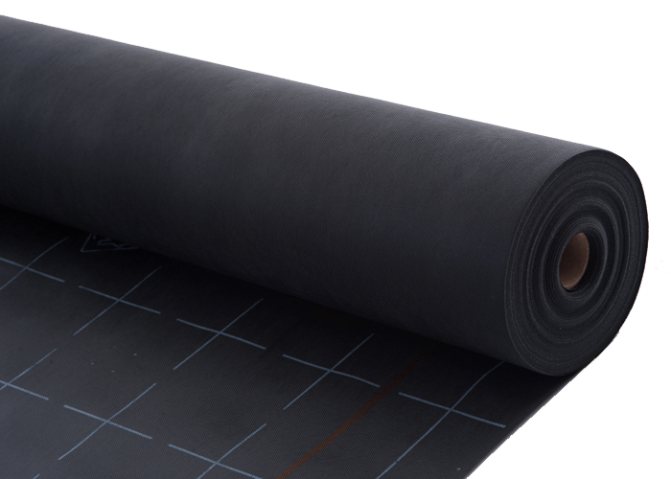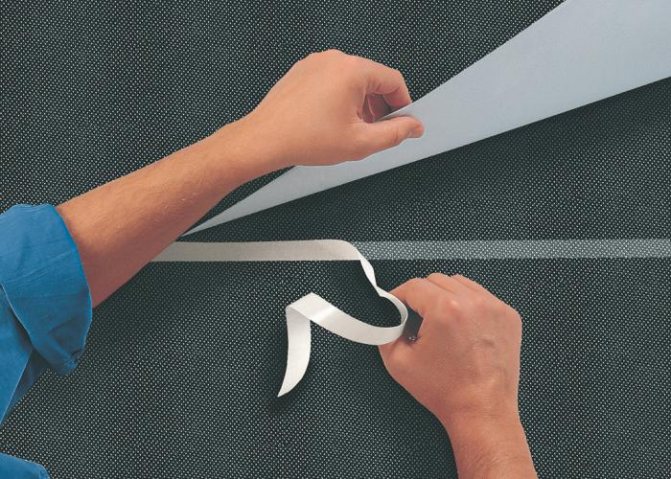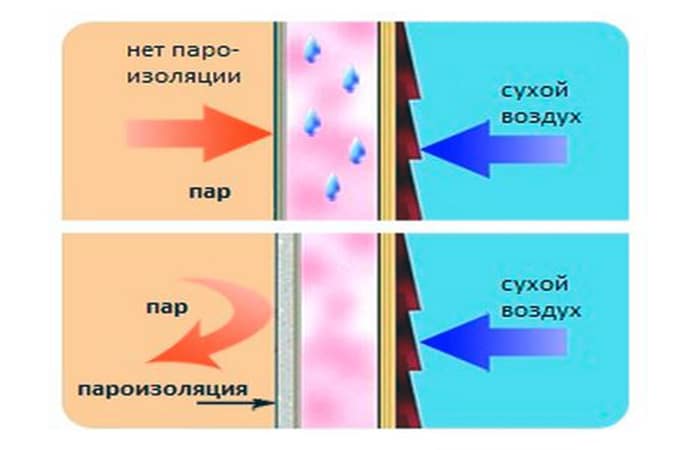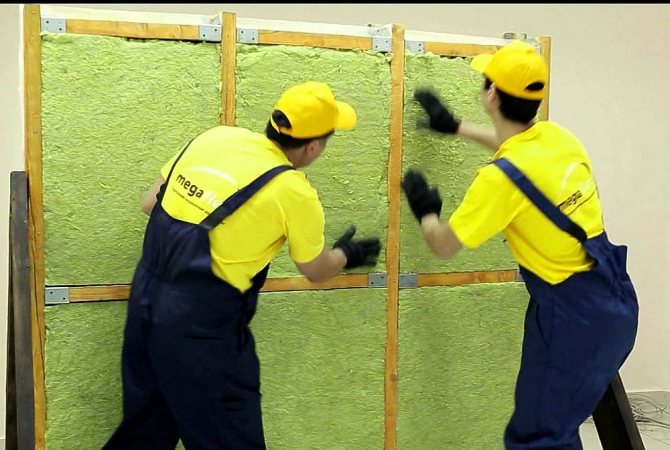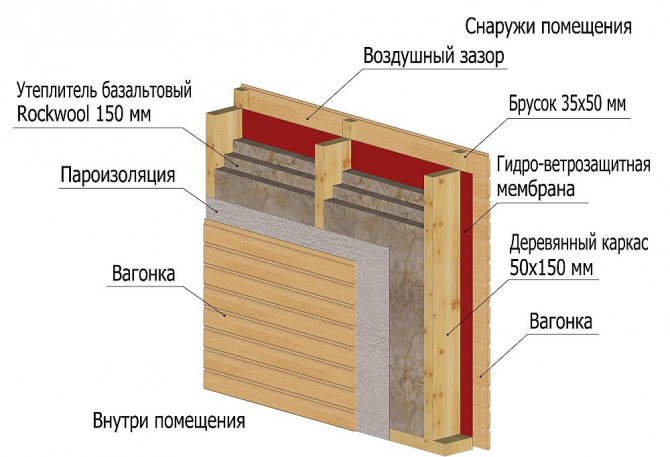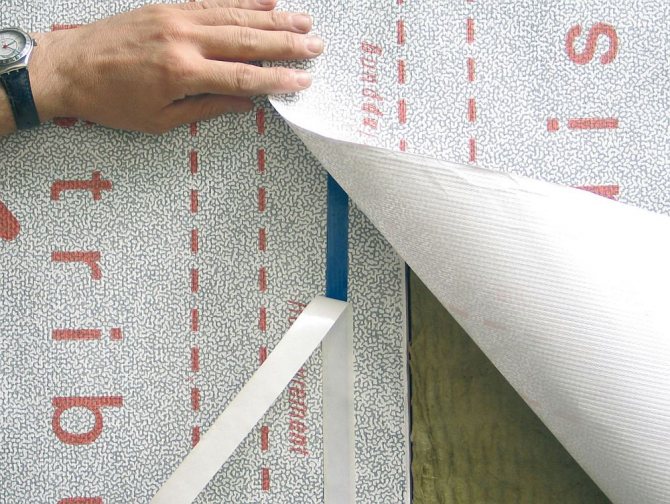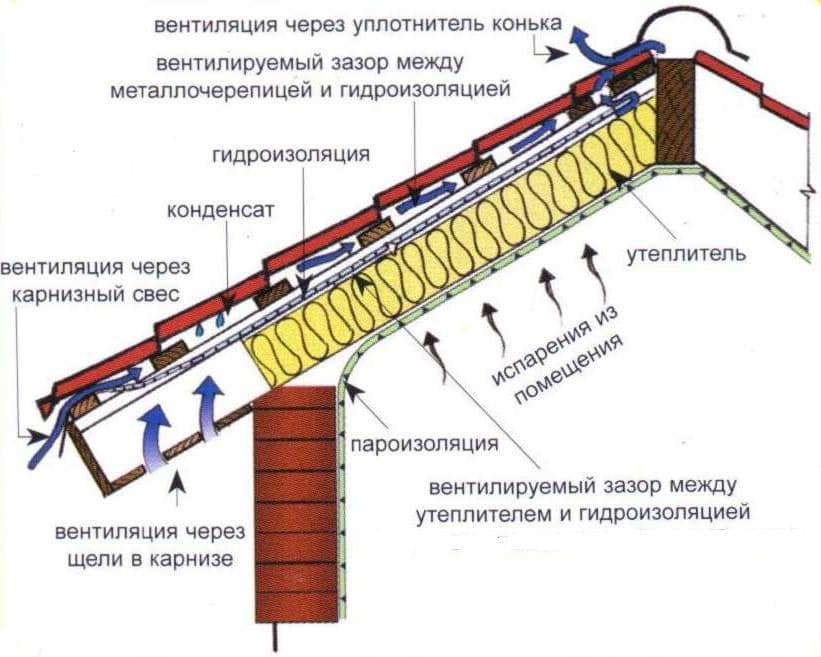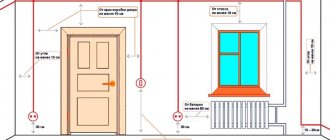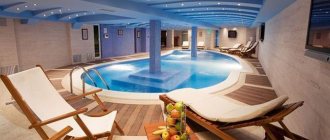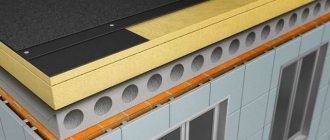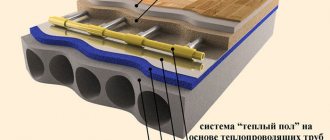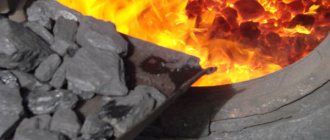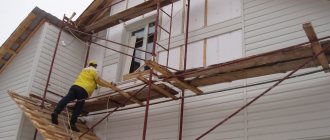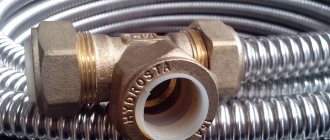Hello dear readers.
I continue the story about my construction site, today I will tell you how I made a windscreen for my house, the whole process of its installation, as well as its role in a frame house. Consider mistakes in the selection of a membrane, installation, as well as the consequences of a misunderstanding of its operation.
Wind protection for the walls of a frame house plays a huge role, the state of the insulation and comfortable living conditions in the house depend on it.
Let's start with a small outline of the article:
- About us
- How wind protection works
- How the membrane works
- Role in a frame house
- Errors in the use of films
- What are the membranes
- Windscreen laying technology
- How did I do
- That, perhaps, I will redo
Here we go?
About us
My first interview appeared on the Internet, I gave it to one very talented teacher Sergei Bondarenko, who, in addition to teaching students, also runs a good website dedicated to teaching computer literacy.

In it you can learn a little about me, about my life, and about how I myself came to IT technologies. Read, judging by the comments, the interview was successful.
Windproof film mounting technology
The main condition for the functionality of the windscreen is its correct installation. The technology itself is simple.
But the work must be treated as conscientiously as possible:
- Rolls of windproof film are mounted horizontally, starting from bottom to top. It is very important to sew on the correct side of the film - usually the outside is the side with the manufacturer's logo. In other cases, you just need to carefully read the instructions attached to the material.
- When installing the film, it is necessary to observe the amount of overlap between adjacent panels: horizontally - 100 mm, vertically - 150 mm.
- The film should fit as tightly as possible to the surface of the insulation - this is an important condition for its correct operation. You can fix the windscreen to the insulation frame with galvanized nails or a construction stapler.
- All joints of the film are glued with special tape so that there are no gaps.
- The bottom of the film should not have contact with the ground. There must be a drain for the removal of condensation formed on the surface of the film.
- Then the film is attached to the insulation frame with vertical bars with a thickness of at least 40-60 mm. This will ensure a snug fit of the windscreen and create the necessary ventilation gap between the insulation and the casing.
How wind protection works
The windscreen actually does two things. Not only does it prevent air masses from penetrating into the insulation in the wind, but also acts as a moisture insulation.
A separate type of films is used for arranging an insulated roof. Such films are often called a subroofing membrane, by the way, for some reason, many builders neglect it, as it turns out in vain ...


Roof membrane
The windproof membrane consists of specially sintered polymer fibers. The film itself is arranged in such a way that on the one hand it is smooth and does not allow moisture to penetrate from the street into the house, on the other it has a rough surface.
Wind protection with foils
The interior decoration of a frame house does not imply the use of films: they are mounted between the outer wall and the heat-insulating layer. The interior decoration of a frame house, with what materials it would not be carried out, cannot in itself provide high-quality protection of the building from blowing.
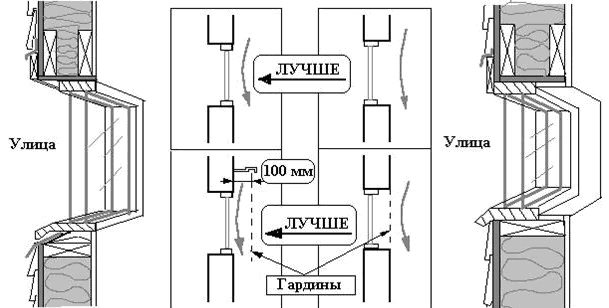

Scheme of installing windows in a frame house
Insulation for a frame house is also unlikely to cope with this function (except when the insulation for a frame house is basalt, but it costs a lot). In general, the cheapest and easiest way to protect against blowing out is to use plain sheeting.
The film, when compared with other similar materials, will have the following advantages:
Roofing material is usually used as a waterproofing material.
- it is non-toxic and non-flammable (in case of fire, it will simply go out, as it is self-extinguishing);
- has excellent performance properties such as elasticity, frost resistance, strength, immunity to mechanical stress;
- ease of installation (if desired, the film can be very easily mounted with your own hands, without the involvement of builders and other specialists, whose work will be quite expensive);
- relative cheapness;
- a long service life (in fact, the service life of the film itself is even longer than the average service life of a wooden frame house as a whole);
- the film can be mounted not only during the direct construction of the house, but also after its completion, during various finishing works;
- filtration of air flows coming from outside the building is completely prevented;
- the house receives additional thermal protection, albeit not as effective as from conventional heat-insulating material such as mineral wool, expanded polystyrene and others.
The polyethylene film also provides additional thermal insulation, albeit insignificant.
In general, it is not difficult to carry out high-quality wind protection of a frame building with your own hands, so there is no need to worry.
Role in a frame house
For a frame house, a windproof membrane is of great importance. Since heaters are used in such a house, it becomes necessary to protect them from moisture and blowing. Probably, many have seen what happens to the insulation when it lies under the open sky.
The fibers fluff up, the trapped moisture does not want to leave it at all, and freezes by winter, which leads to the loss of the thermal insulation properties of any mineral wool insulation.
This has little to do with foam, it is not afraid of moisture, and is not subject to moisture accumulation. Therefore, the use of a membrane in a house with foam insulation may be considered optional by many.
But this is a misconception, the film also protects the building frame from atmospheric influences, and fulfills its function of protecting from the wind. In any house, this is very important, even a log house, especially a lumber one.
Features of the use of different types of wind protection
In addition to diffuse membranes, in practice, they often use rigid insulation options, for example: OSB, fiberboard plates and Isoplan panels. Let's consider the pros and cons of each type of wind protection, and note the specifics of their application.
Using OSD: the pros and cons
Sheathing the outer walls of a frame house with OSB slabs solves several problems. Rigid slabs are the basis for subsequent cladding and effective wind protection.
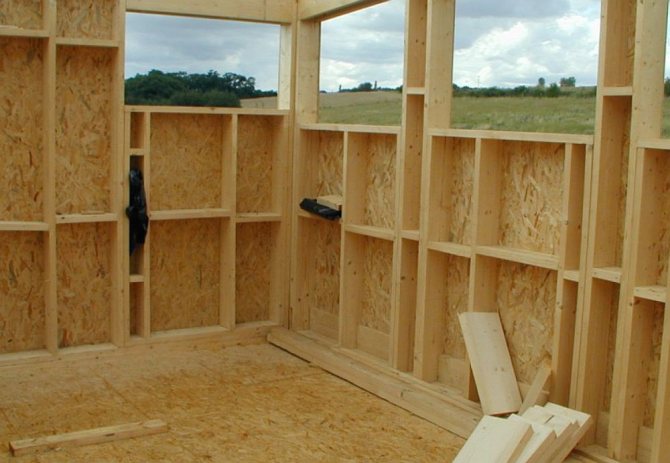

Material advantages:
- providing additional heat and sound insulation;
- strength - OSB perfectly restrains wind gusts;
- sufficient vapor barrier;
- environmental friendliness.
However, OSB does not tolerate a humid environment well and needs additional waterproofing... In addition, rigid, oriented strand boards tend to change their linear dimensions with temperature changes. As a result, the formation of gaps between the sheathing sheets and the blowing of the walls.
Some for OSB waterproofing suggest covering the slabs with plastic wrap.But such a solution negates the vapor permeability of the substrate, and is fraught with undesirable consequences: wetting of the insulation, deterioration of the microclimate in the house - an increase in humidity, the appearance of dampness.
Useful: Izospan films and membranes (A, B, C, D, AM) - instructions for use
Izoplat - insulation and wind protection
Isoplat is a sheet material made from softwood. No glue is used for pressing the fibers - forming into plates occurs due to the softening of a natural polymer.
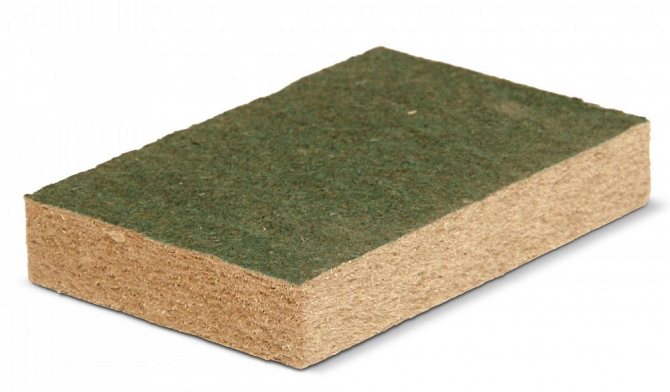

Izoplat characteristics:
- high thermal conductivity - 0.045 W / (m * k);
- moisture resistance due to the treatment of the outside with paraffin;
- fibrous structure provides good vapor permeability;
- sound insulating ability - reducing the noise effect by 23-26 dB;
- high density - 230-270 kg / m3;
- environmental friendliness, biostability and relative fire safety - when ignited, the material is charred, and the resulting ash blocks the access of air to the wooden frame;
- simplicity of installation and tightness of the docking of the windproof plates due to the “thorn-groove” fixation.


Main disadvantage of Izoplat - significant financial costs for arranging the wind protection of a frame house. Despite the declared moisture resistance, manufacturers do not recommend leaving the sheets open for a long time. Excessive wetting can lead to a change in the geometry of Isoplat - the material is taken in "waves".
Windproof properties of fiberboard slabs
The material consists of 50-60% wood fibers, the rest is made up of Portland cement and various additives. This structure has endowed the slabs with a number of positive characteristics:
- high water resistance along with vapor permeability - fiberboard plates "breathe", maintaining a favorable microclimate, and are not afraid of moisture;
- fire safety - the material tolerates high temperatures, and does not emit toxic substances during combustion;
- low thermal conductivity - wood-cement sheets reduce heat losses in the room.
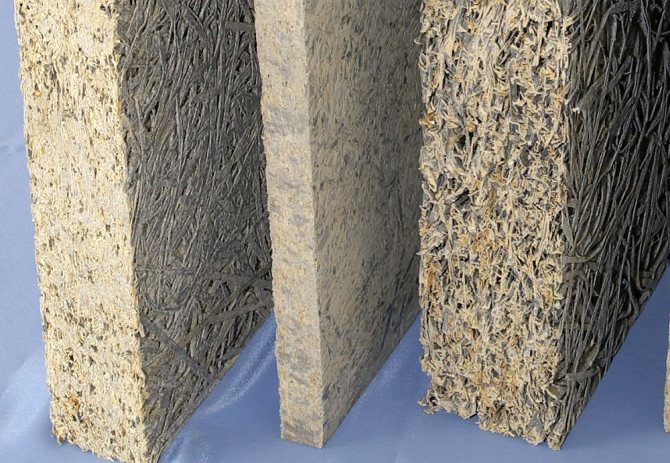

An additional plus is strength, the density of fiberboard is 250-1050 kg / m3. Plates provide reliable protection of the frame from adverse external factors, including gusts of wind. In addition, the material is easy to process, it can be milled and cut. Fiberboard is a good base for finishing: facade plastering or siding fastening.
Many experts consider fiberboard sheets to be the optimal solution in frame construction - the material meets all the requirements for wind insulation.
Facade plasterboard - rough cladding
Drywall for outdoor use, thanks to the hydrophobic impregnation, becomes a good protective screen against climatic influences. Facade gypsum plasterboard prevents the fibers of insulating materials from blowing out and moisture penetration into the insulating layer.
The main advantages of drywall, like rough cladding:
- leveling the surface of the walls;
- wind insulation for any wind rose - the erected barrier adjusts the air pressure, while maintaining the vapor-permeable properties of the insulation;
- protection against precipitation and condensation;
- resistance to temperature fluctuations - the material does not change shape and size;
- environmental friendliness and frost resistance.
Compared to fiberboard and isoplate, plasterboard finishing is cheaper. However, the material will not provide additional thermal insulation like its competitors.
The disadvantage of facade gypsum board is possible deformation and destruction of the structure during prolonged contact with liquid or regular exposure to high temperatures. Drywall should not be left open for a long time and used for windproofing the roof.
Diffuse membranes for special applications
The windproof diffuse membrane is actively used in both frame and capital construction.Its main purpose is to protect the insulation from moisture while maintaining the vapor permeability of the heat-insulating material.
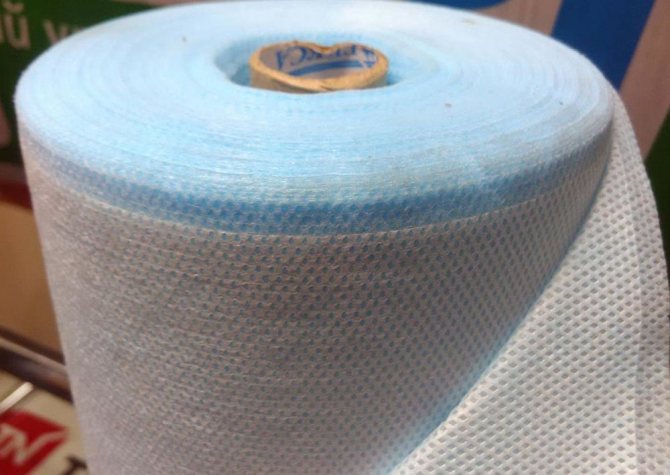

Diffuse membranes have a number of advantages:
- strength and elasticity;
- ease of installation - installation can be performed at any outdoor temperature;
- compliance with the main requirements of wind protection: vapor permeable in one direction and resistant to moisture;
- fire resistance and environmental safety;
- immunity to UV rays and different temperatures;
- durability of operation.
The membrane maintains normal ventilation of the insulation, helps to remove wet vapors from the room, providing the most comfortable microclimate.
The main competitive advantage is the opportunity temporarily do without finishing material... The diffuse cloth will protect the structural elements for several weeks. A more durable superdiffuse membrane will perfectly cope with the role of a temporary roof.
Useful: How to pour a screed on a wooden floor
Spunbond - expediency of use
Spunbond is a covering material characterized by high permeability. Geotextiles are used mainly in horticulture and horticulture, but some craftsmen have learned to use it in frame house-building.
Strengths of spunbond as wind protection:
- good breathability;
- high strength, elasticity and ease of installation;
- resistance to adverse factors: operating temperature range - from -50 ° С to +100 ° С, biological and chemical inertness.
A controversial point in the advisability of using geotextiles is water permeability. To minimize the likelihood of water penetration to the insulation, you should adhere to the nuances of installation:
- fasten the canvas vertically to protect the walls;
- do not use for insulation of roofs if the slope angle is less than 35 °;
- to equip the ventilation gap under the layer of wind protection for better "airing" of the spanbond and insulation.
Errors in the use of films
Very often inexperienced builders make mistakes when choosing and installing a windscreen for a home. A common phenomenon is the use of vapor barrier outside the house. People simply do not understand the principle of the film, and they think that the house can be wrapped in any kind of film.
When buying, carefully look at what kind of film you are offered! There are not always smart sellers, and you can easily buy a membrane designed for vapor barrier.
I myself saw such houses, a pitiful sight, but they are already sewn up with siding or even better metal profiles. When applying vapor barrier instead of wind protection, moisture is not removed from the structure of the walls, and falls into condensation.
As a result, the walls get wet, and if this is a frame house, then the damage to the insulation is one hundred percent, and if the blockhouse, then hello fungus, mold and rot.
Another mistake is the use of a profiled sheet as a facade of a house with its laying directly on the wind and moisture protection membrane, and, accordingly, on the insulation. The film simply ceases to perform its functions and condensation reappears.
Make a vertical ventilated gap between the facade and the membrane. This will allow vapors and moisture that appears on the membrane to evaporate freely, and you will protect yourself from the problems described above.
How to choose a windscreen
When choosing a windscreen for ventilation facades, specialists pay attention to:
- toxicity of building material.
- resistance to temperature extremes, UV radiation, high humidity.
- the duration of the operational period.
- fire resistance, fire safety.
- type, kind, category, density.
- the degree of reliability.
- tear resistance, sufficient elasticity.
- chemical resistance to acids, alkalis.
Important! Give preference to building materials, the installation of which can be carried out in any season of the year.
Pay attention to the cost, the reputation of the manufacturer.Building materials that are too cheap in price do not have all the necessary technical properties. The best option is diffuse, superdiffusion films.
What are the membranes
There are a huge number of wind protection films on sale. They all differ both in price and quality. If you do not want to take risks on your home, then do not skimp. A quality membrane cannot be cheap.
On my own I can divide films into three types:
- Cheap membranes, outwardly very similar to a covering material, I would not use them for home. Sew up a shed, there is a garage, well, or use it as a flooring for loose insulation on horizontal surfaces.
- More expensive and high quality windproof films with different surface structures and high density. This was used for the walls of the house, brand Ondutis A120.

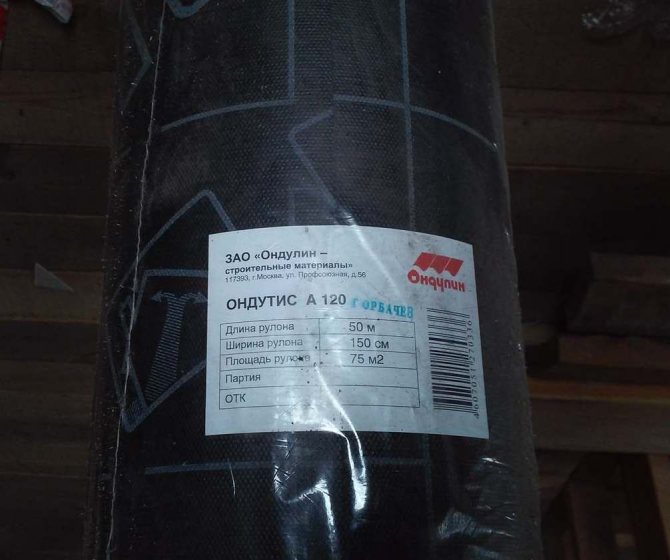
I bought such a membrane
This is the best thing that I had in my hands from the commercially available in our city. Certainly not Tyvek, but still a pretty dense film. (If Tyvek would have taken it) - Superdiffusion membranes. These films are used for insulated pitched roofs. They absolutely do not allow water to pass through themselves from outside to inside, and easily release steam outside. Often they are made in multi-layer, in order to obtain the corresponding properties. Well, of course, you can also use them on the walls. They are absolutely not blown by the wind.
Insulation materials
47 votes
+
Voice for!
—
Against!
Windproof membrane is a fairly new material on the construction market. Its demand began to grow with the peak of the popularity of the construction of frame houses. But besides this, such a membrane material is very important not only for insulating the walls of a house, but also for arranging the roof, where it has become an integral layer of the "pie". This stage during construction work should be provided at the design stage or at the very beginning of the repair. This article will focus on how to choose a windproof membrane for your home and how to install it correctly.
The importance of hydro and windproof membranes for the home
- Regardless of what material the house is built from, when insulating it, it is imperative to provide a windproof layer. Its task is to protect the thermal insulation material from the effects of strong air currents, partially absorbing air pressure. But, at the same time, without reducing the vapor-permeable characteristics of the material with which the facades of the house are faced. Therefore, we can conclude that it is the windproof membrane that guarantees the preservation of all important characteristics of the insulation, allowing it to extend its operational life.
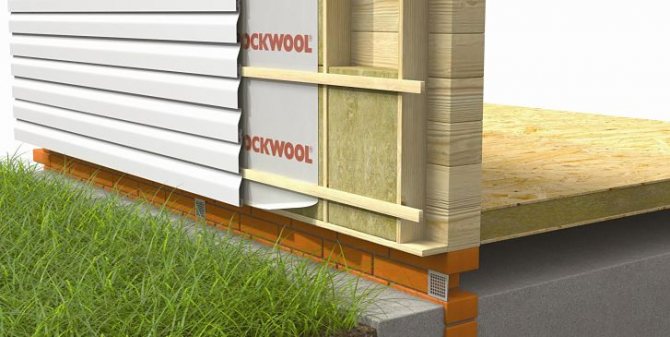

- But do not forget that from inside the house you need to make a vapor barrier membrane film, which will protect the insulation from water vapor. When wet, it immediately deteriorates its properties and high heat loss begins.
Tip: a windproof single-layer or two-layer membrane is used only on the outside on top of the insulation, and the vapor barrier membrane from the inside of the house, as a finishing layer before installing drywall.
- The importance of using windproof membranes is due to several factors. First of all, this is infiltration, that is, when warm air from the house passes out through very small cracks in the structure of the wall material. This occurs especially often in wooden houses, when the wood dries up. The second reason is the ventilation of the walls. Even such dense materials as brick or foam block have sufficient porosity to allow air to pass through. The presence of a windproof film helps to cope with these shortcomings, and, without affecting the vapor barrier properties, stabilize the indoor microclimate.
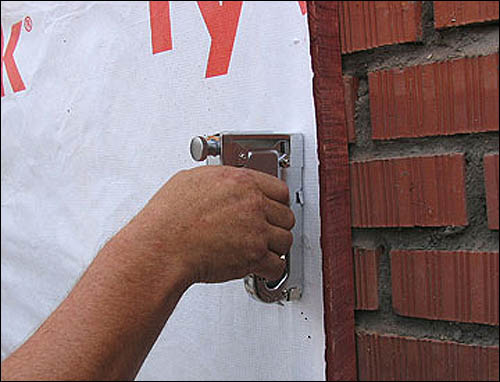

- In addition, the use of a windscreen will protect the insulation from excessive moisture due to the resulting condensation, which often becomes the cause of mold formation.
Today on sale there is a very wide variety of windproof membranes, both foreign and domestic. They all vary greatly in price and properties. According to their technical characteristics, windproof membranes for the home can be divided into:
- vapor-permeable film, promotes the penetration of excess steam from the room, while protecting the insulation from rain and cold winds;
- vapor barrier film, mounted from the side of the living quarters. Its function is only to remove steam, it cannot be attached from the outside;
- multifunctional membrane, its name speaks for itself. Despite the apparent convenience, it is used much less often.
Benefits of Using a Windproof Membrane
- Environmental friendliness of the material... It is absolutely harmless to both humans and the environment.
- Fire resistance... It is achieved thanks to the special additives that it contains. They allow you to suppress combustion.
- Ease of use, easily mounted at any time of the year and does not require personal protective equipment.
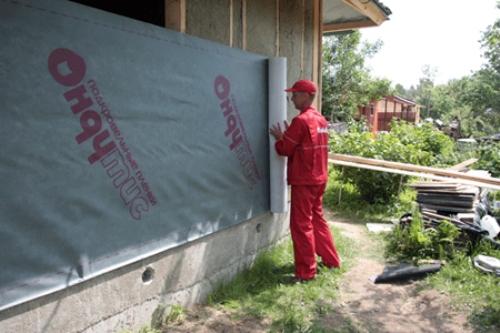

- High technical characteristics... So, it is resistant to ultraviolet light, moisture resistant, elastic, resistant to mechanical damage and strong temperature extremes.
- Duration of operation... It does not lose its properties for many decades.
Depending on what goals they want to achieve, the windproof film is attached to the walls of houses, the roof or to the ceilings of the attic floors.
Variety of windproof materials for the home
- Not so long ago, there were no special windproof membranes on sale, but there was a need for a podomnaya material. Therefore, there are several alternative materials that are acceptable for use, although today they are not recommended. Although their cost is lower, their characteristics are significantly inferior to new high-tech materials.
- Perhaps the cheapest of all possible materials for windproofing walls is glassine. But, despite its low price, its appearance is so unattractive that it is most often made as a temporary solution with further dismantling.
- Until now, in private construction of small houses, ordinary plastic wrap is used as wind protection. But, due to the very low vapor-permeable properties, excess moisture can accumulate in the heat-insulating material, leading to sad consequences. Vapor permeability is important not only for the insulation itself, but also for the construction of the walls, especially when it comes to a wooden house.
Breathable Windproof Membrane Manufacturers
"Ondulin"
This brand occupies one of the leading positions in the windproof membrane market. It has been known for over 25 years, during which it has established the high quality of its products. Hydro-windproof film is sold under the name "Ondutis" and, depending on the purpose and properties, is available in several names:
- SA 115 - this insulating material is a vapor-permeable membrane that is capable of retaining moisture and gusts of wind, while not rotting and has a high resistance to tearing and the influence of ultraviolet radiation. It is used to protect insulated structures, walls or roofs from condensation, atmospheric moisture and strong winds;
- A 120 - also suitable for use on wall and roof structures. A distinctive feature is a higher indicator of resistance to solar radiation. It is usually sold in rolls 1.5 m wide and 50 m long.
- A 100 - in fact, an analogue of the previous one, but cheaper. This is due to the lower strength and limitations of the temperature regime of operation.
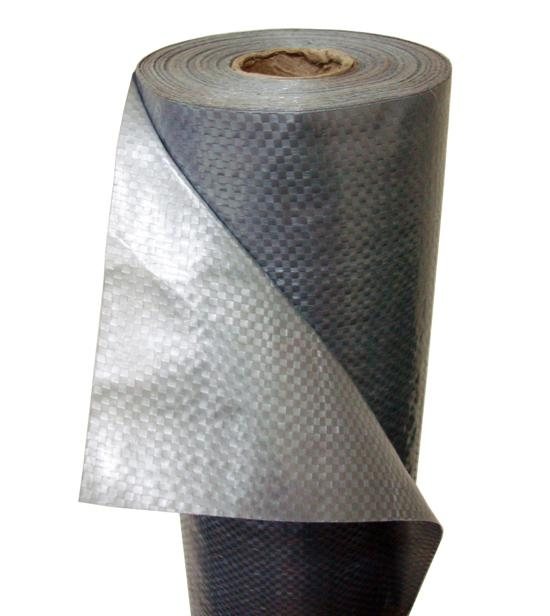

Izospan
This is an excellent combination of price and quality, so you can buy it at any hardware store. The isospan windproof membrane is quite versatile and suitable for use in insulated roofs with a coating of any roofing material: metal, natural tiles or bituminous tiles.
On sale, in addition to the most famous and popular models, there are products with increased fire-resistant qualities. Special fire retardants in the fabric itself help to achieve this, this can protect the structure from fire, both during construction work and during operation. Although its price is higher, in some cases fire requirements allow the use of only such a membrane.


Isospan wind protection was constantly improved, which made it possible to achieve a number of advantages over other analogues:
- compactness and low weight... This is the presence of small rolls that are easy to transport even in public transport;
- convenient sizes... They allow even one person to mount the material, but at the same time they will not create an unnecessarily large number of joints;
- high strength characteristics... They make it possible to work even in adverse weather conditions, while the risk of tearing the material is minimized;
- low price... Considering the high consumption of the film, this is an important component when choosing;
- elasticity, resistance to UV rays, temperature extremes, etc.
Depending on the specific construction goals, you can also choose the most acceptable option from the line that the manufacturer represents:
- Izospan A - This windproof is designed for outdoor use. Fastened to the wall of the house under a ventilated facade or under a roof covering. Its purpose is to protect structural elements and insulation from wind and water. Improved Izospan A with fire retardant properties is also sold;
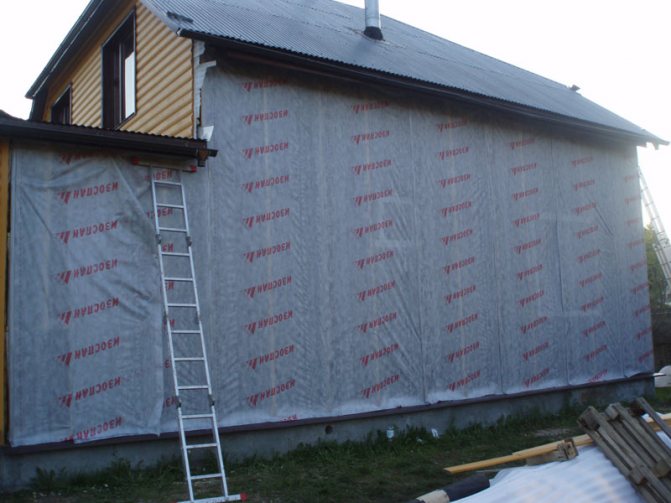

- Izospan AM Is a two-layer membrane material with high vapor-permeable properties. It will perfectly protect the insulation from condensation, atmospheric humidity and weathering. This is achieved thanks to the special structure of the fabric, the creation of which became possible only with the use of modern technologies. This guarantees high water resistance characteristics during long-term operation in the most extreme weather conditions;
- Izospan AS - although it is the most expensive in its line, as it is a three-layer material, but thanks to the method of installation it is able to reduce costs. So, it is allowed to mount it directly on top of the insulation, without the equipment of the lathing for the ventilation gap.
Windproof membranes "rockwool"
These are vapor-permeable wind-moisture-proof materials that are available in different brands. The choice depends on the specific conditions and the goals to be achieved. They are all sold in standard rolls of 70m2.
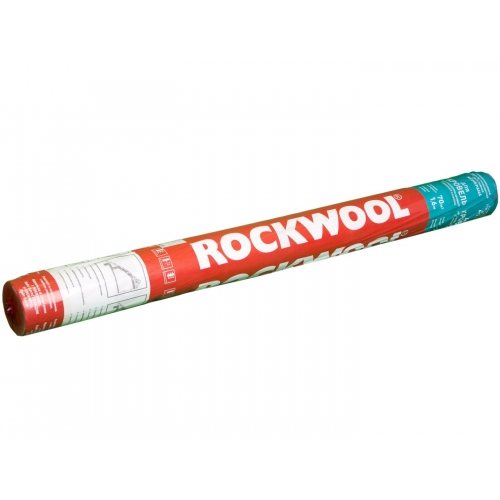

- Rockwool roof... This is a two-layer membrane that meets all the basic requirements. It successfully removes condensation from the roof and protects the insulation from the wind. When using it, it is imperative to make a vent gap of up to 5 cm. The roll width is 1.6 m, so it should be placed on the roof in horizontal strips with a gap of at least 15 cm. The upper strip of material is laid 5-10 cm away from the ridge.
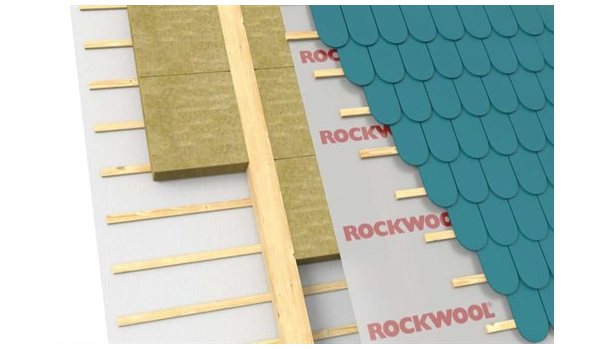

- Rockwool partitions. It is chosen if the facades of the house were insulated from the outside. It serves as a protective layer between the thermal insulation material and the outer cladding, siding or any other material. It is fixed directly on top of the insulation, pressing it with slats, to which the decorative wall cladding is later attached.
- Rockwool partitions with fire retardants... It completely retains all the functions and purpose of the previous type, but it contains special flame retardant additives that allow protecting the structure from fire for a while.
Types of construction membrane films
All membrane materials for home construction can be divided into several main categories. So, depending on the structure of the material and its purpose, there are vapor-permeable and vapor barrier films.
Vapor barrier membrane
- It is always mounted only from the inside of the house, protecting the wadded insulation from moisture accumulation in it from condensation. For example, when arranging an attic roof, the bottom of the insulation is covered with just such a film. It can look different: in the form of a smooth paper film of high elasticity and strength with a glossy side, or in the form of an aluminum film with a foil side.
Advice: the presence of a vapor barrier on the wall and roof structures of the house creates a "thermos" effect. This is good for energy saving when heating, but it will greatly increase the humidity in the room. Therefore, supply and exhaust ventilation systems must be installed in them.
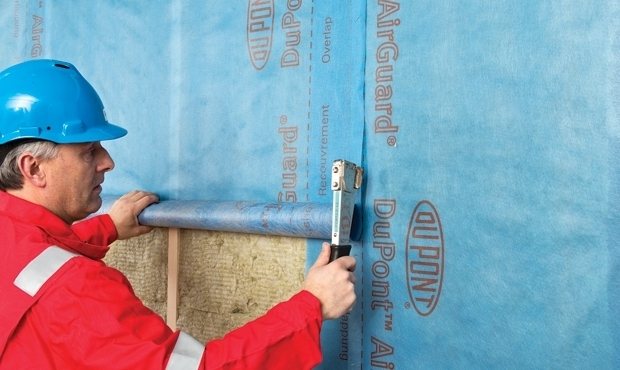

- Special membrane materials are available to protect metal roofing materials such as metal tiles or corrugated board. These films have an anti-condensation coating that protects the metal from corrosion. The principle of its operation lies in the structure of the coating on one of the sides - it is rough to the touch, as it is an adsorbent layer that absorbs condensate rising from the room. A ventilation gap of 2-5 cm is left between such a membrane and the insulation.
Breathable windproof membranes for walls and roofs
- They are used outside buildings on top of insulation under cladding or roofing material. In addition to the fact that it successfully protects the soft insulation from wind damage, it also contributes to an additional waterproofing layer. Since windproof membranes are a kind of buffer between the thermal insulation and the external environment, it is important that they allow all possible moisture to pass from the room into the ventilation gap. This is possible due to the presence of very small perforations, which are invisible to the naked eye. It follows from this that the higher the throughput of the windproof vapor membrane, the more efficiently it will work. According to this principle, it is divided into: diffusion, superdiffusion and pseudodiffusion.
- Pseudodiffusion materials in most cases are used in the construction of the roof. This is due to their good waterproofing properties and successful operation with a properly organized ventilation gap. But it is not recommended to lay such a windproof membrane on the facades due to the low vapor permeability characteristics. Its pores are so small that they can easily become clogged with dust under strong air currents and stop working.
- The best windproof membranes for home walls are diffusion and superdiffusion. Their vapor permeable properties are so good that you don't have to worry about clogging. Due to the large number of pores of a rather large size, manufacturers guarantee the correct operation of such materials, even without arranging ventilation crate over them.


- Separately, it should be said about this type of windproof films, as volumetric diffusion membranes. This is a great option for roofing work. They are quite dense mats up to 3 m long and about 8 mm thick. Such bulk polypropylene plates are an independent layer that separates the insulation and the roof covering without additional ventilation. This guarantees a high-quality drainage of condensate formed under the roof, extending its service life. For its fastening, ordinary nails are used, but the base for it can only be a continuous coating, for example, from plywood.
Installation of a windproof membrane. Frequently asked Questions
- Which side to mount the windproof membrane? If the house is insulated with mineral wool, then it is fixed from the outside directly on top of the insulation. The same is done when working on an insulated roof.If the roof is not insulated, then instead of a windscreen, a vapor barrier is attached from the bottom of the rafters. When the walls of the house are insulated only from the inside, then the vapor barrier film is mounted only from the side of the room.
- Which side to lay the membrane on correctly? As a rule, all membrane tissues have a front side, which is rather difficult to distinguish and takes a long time to look closely. But you can't be wrong, since the location will depend on how it works. So, the roofing anti-condensate wind protection is attached with the absorbing side inside the room. Today, well-known manufacturers of diffusion materials began to mark one of the sides and indicate in the instructions on the rolls exactly how it should be positioned.


- Is a ventilation gap required? In most cases, it is needed. For example, when arranging a vapor barrier from the side of a living room, a gap of 2-3 cm must be left between it and drywall.And here windproof diffusion materials can be attached without additional ventilation between the insulation, but it must be done between the finishing cladding of the building. The frame of the slats is fixed vertically so as not to impede the air flow. The roofing anti-condensation film must have a ventilation of 5 cm on both sides.
- How much to overlap the canvases of the windproof membrane? The most famous manufacturers make marking tape on their products, which indicates the optimal size of the overlap. For walls, in most cases, it varies from 10 to 20 cm. But when installing a roof, this indicator depends on the degree of inclination of the roof, the smaller the slope, the greater the overlap should be left. In the area of the joint with the ridge, the windscreen should have an overlap of at least 20 cm, and on valleys up to 30 cm.Often, in these places it is recommended to mount an additional layer in the form of a strip with an overlap of 40-50 cm on both slopes.
- Do I need to glue the joints of the windproof membrane? This is a prerequisite that all manufacturers prescribe. This is the only way to achieve absolute tightness of the joint. For these purposes, any self-adhesive tapes are suitable, but it is best to use reinforced construction tape. Although its price is much higher than ordinary paper, it guarantees excellent performance for many decades. It can also be used to repair a gap. But first, put a gasket inside in the form of a piece of windscreen, and then glue everything.
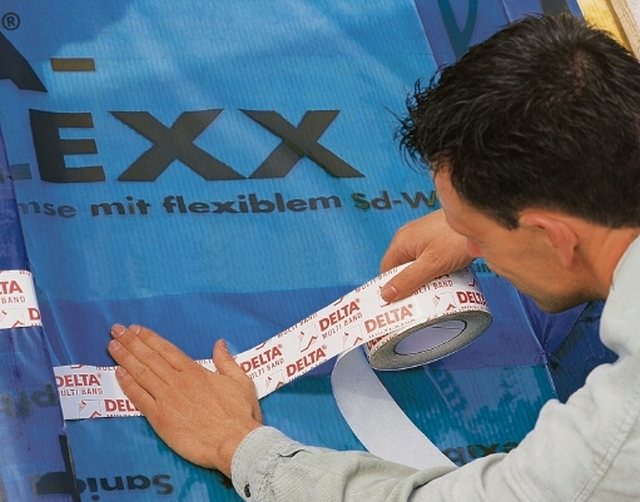

- How to fix a windproof membrane for a home? A construction stapler is used for tension and temporary fixation. But this is only a temporary measure, the slats must be firmly screwed on top, which will serve as a crate for further facing work. But with the further arrangement of hinged facades, the work will be more laborious. First, brackets for hinged panels are attached to the wall, after which plates of heat-insulating material are mounted on dowel-nails with mushroom caps. After that, a windproof membrane is pulled over the top and, applying it to the wall, slots are made for each bracket. And immediately, right through the heat-insulating material, they are attached to the wall with similar nails-fungi. Their number should be at least 5 pcs / m2. If it is not difficult to nail a counter-lattice around the perimeter of the windows, then at the joints with pipes, antennas, ventilation ducts, the edges are glued to double-sided tape or special rubber glue.
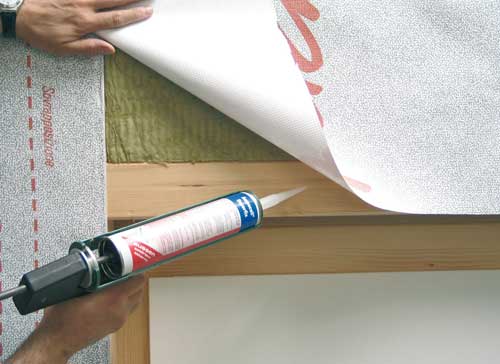

- How long can the windscreen be left uncovered? Although manufacturers assure that their materials are resistant to ultraviolet rays, this period is limited. So, after 5-6 months, the material begins to "age", losing its properties. Therefore, it is recommended to cover the windscreen with cladding as soon as possible after installation.And also, if the windscreen gets under prolonged rain, it gets wet and begins to let water through to the insulation and to the very structural elements of the house. Therefore, it is more convenient to make each wall separately, immediately mounting all layers with cladding, and not the whole house in stages.
Windscreen laying technology
Before starting the installation of the windshield, prepare:
- The required amount of film, counting the squares of the walls.
- A stapler and staples, staples still in your pocket, when you hold a four-meter-long canvas, you really don't want to run after the staples that run out.
- Scotch tape for gluing canvases. Look for the best one recommended for these purposes.
- Assistant, preferably more than one, especially on the roof.
The principle of laying the film both on walls and on a pitched roof is practically the same.
- We roll out a strip of the required length along the wall of the house, check for the correct position with the smooth side outward (in general, it should be written on the film which side is outward, so if this is not the case, then read the documentation for the membrane)
- We pull the windshield along the wall of the house without fanaticism, then punch it with a stapler to the racks or slab sheathing, depending on the structure of the building.
- We glue a special double-sided tape to the upper edge of the film, do not remove the paper from the tape. We will later pull it out from under the upper film
- We roll out the next row of film and also shoot it. We continue until the wall is completely filled from bottom to top.
- We pull out the paper from the tape and carefully glue the membranes together.
- We nail in vertical bars to organize the ventilation gap, with the frequency necessary for a particular type of facade. It is on these slats that we fasten the facade of the building.

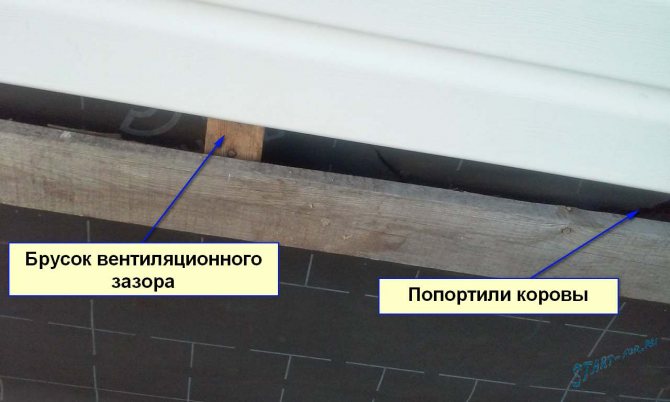
Ventilation gap bar
It is important to close the windscreen as soon as possible, over time the film loses its properties as a result of exposure to sunlight. Each film has its own timing, but I would close in the first month after installing the membrane.
For the roof, everything is done in the same way, from the bottom up, and with gluing. You just need to be careful, it is very inconvenient to climb the rafters, and click the stapler. Long arms or a helicopter)))
Membrane laying technology consists of the following points:
- Laying with the right side - rough inward, smooth outward.
- It is more convenient to strengthen the material vertically, although this is not critical.
- The film is rolled and stacked exclusively from top to bottom.
- Cutting the film can be done with any sharp knife.
- When trimming, a 10-15 cm allowance is left for fixing to the wall.
- Fastening is carried out with dowels with plate hats.
- Use at least 5 dowels per square meter.
- The strips of material are laid with an overlap of at least 10 cm and fastened together.
Sergey Yurievich
Construction of houses, outbuildings, terraces and verandas.
Ask a Question
As you can see, the attachment of the protective layer is a simple elementary process. The films are supplied in ready-made rolls of 1.5 m width. They should be unrolled, fastened with a stapler and nailed with dowels. The choice of fastening between dowels or a stapler is made based on the height of the wall. On the walls of two-story frame houses, you can nail stripes one by one, not forgetting about the overlap.
How did I do
In my house, I used two types of membranes, for the walls I took an ordinary windproof film, and for the inclined parts of the attic, a super diffusion.
When insulating the attic, the use of a superdiffusion membrane is more relevant. When laying the insulation, you can not steam with a gap between the film and the insulation, but lay the mineral water tightly. This gap is required when using conventional windscreens.


House wall
He stretched the canvas as he described, started from one corner and walked around the whole house with a roll, at the same time fastening the film to the racks. When I finished the first row, I started the second, and so on to the very top.
It was interesting to attach the membrane to the rafters, the roll is wide, the rafters are high, just as we were not perverted, but we did it! Two rows of membrane on each ramp of the superdiffusion, and one row of conventional windscreen. I put the usual one where the non-insulated part of the slope is.


Three rows of windscreen
For gluing I took scotch tape, the same company Ondutis, I want to say right away, it dries up in the sun in a moment, and everything comes off. Where I closed it with siding did not come off, and everything sticks. In theory, the adhesive of these tapes should not dry out under any circumstances ... I glued it again after installing the siding, it seems to hold on.
Windproof films
Wind protection is used when a ventilated facade is planned using external insulation.
Do not think that only new buildings are insulated this way. This option can be used and, if necessary, insulate the old building.
Moreover, this method is successfully used for insulating not only frame and wooden houses - it is suitable for concrete and brick walls.
Windproof films are also used to protect floors, ceilings and roofs. The only condition is to use them only from the "cold" side: directly under the roofing, subfloor or on the street side of the outer walls.
All windscreens are divided into two types:
- Moisture-windproof films are materials with high vapor permeability (≥ 3000 g / kV. M per day), but low water resistance (approximately 250 mm of water column). These are two-layer films, the smooth outer side of which protects the insulation from atmospheric moisture in the form of rain or sleet, and the inner porous side releases water vapor from the insulation, sending them into the ventilation gap between the windscreen and the facade cladding. Also, this film protects the insulation from the effects of air pressure that occurs in strong winds.
- Superdiffusion membranes - with a vapor permeability of 1000 g / m2 per day, they have a water resistance of about 1000 mm of water column. They are more expensive than conventional windscreens and are designed for use in areas with high rainfall and high winds. In such conditions, with insufficient tightness of the wall cladding, the insulation can be highly moistened, which noticeably affects the energy efficiency of buildings. The three-layer structure of the membrane perfectly removes steam from the thickness of the insulation, reliably protecting it from snow and rain, which increases the service life of the insulation several times.
What mistakes should be avoided when installing a windscreen
Of course, the first mistake is to mount the film outside the house and, conversely, the vapor-permeable membrane inside the room. It must be remembered that the membrane cannot perform the function of waterproofing, but the film will quite cope with it.
It is also worth considering the peculiarities of the building itself and the weather conditions. If storm warnings are not uncommon in the region, the house is subject to shrinkage, temperature extremes, and so on, then this all affects the joints of the windshield sheets. Therefore, vertical overlaps are often additionally pressed with slats.
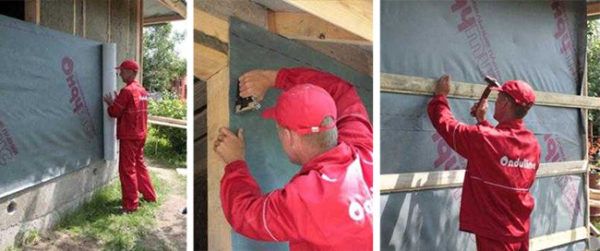

Some people use a windscreen as a temporary roof. Such a "greenhouse" will not last long. Since the membrane is not designed for such loads, it will quickly rupture. Even on walls, it is not recommended to leave the membrane unprotected for a long time. A shower, hurricane or hail will damage it. The same goes for sheet windscreens. She might get wet. Therefore, it is worth planning the work so as to close this layer as soon as possible.
What materials are used
Wind protection of a frame house is a necessary stage in its construction. Therefore, it is not surprising that with the growing popularity of such structures, manufacturers began to mass produce various types of membranes. They differ among themselves not only by the brand, but also by the material from which they are made.
The variety of materials poses the question of choice for the developer. Choosing between different types of modern materials is not so easy if you do not know their characteristics. Today, most often you can find such options for a windproof film with the corresponding advantages and disadvantages:
- Izospan;
- Wood fiber in the form of slabs;
- Special OSB-plate;
- Fiberboard board;
- EPPS plate.
The first option is the most common type of windscreen and the classic version of the insulating film. Izospan is a non-woven artificial material that is distinguished by extremely high strength and durability indicators. Despite its artificial origin, this membrane is distinguished by the fact that it emits toxic substances during combustion and does not smoke at all.


Manufacturers make isospan film of several types. The main difference between them is the number of layers from which it is woven. With the help of a different number of layers, the ability of the material to withstand temperature changes can be adjusted. A well-made membrane is able to withstand even arctic cold. Also, manufacturers of modern films provide for tension regulation.
Wood fiber is considered an environmentally friendly material, and it is used where this indicator is extremely important. It is less durable and stronger than Isospan and is more expensive. But, at the same time, it allows you to maintain a special microclimate in the house. This material has good vapor barrier properties.
It is pressed into special, very thin and flexible plates that adhere tightly to the thermal insulation. Due to the natural characteristics of wood fiber, it removes moisture well through the pores in the boards.
An additional protection of the plates themselves from moisture is a paraffin coating.
Wind protection of a frame house from a facade plasterboard will require an additional waterproofing device. An important advantage of this method is that it significantly increases the rigidity of the entire structure. This makes the building more resistant to strong wind gusts. In combination with a special waterproofing membrane, OSB-board windshield can be considered the most economical option.
One of the most modern facade windproof materials for frame structures is fiberboard. It is a slab made of a mixture of liquid glass, cement and wood shavings. As a result, fiberboard combines the positive qualities of three different materials.
It is quite durable and, at the same time, allows moisture to evaporate well. It has good sound insulation properties, because of which the house will not need additional protection from sound. Fibrolite is unique in that it returns to its original form, even if it is well wet, as soon as it dries.
The abbreviation EPPS hides compressed polystyrene, from which special plates for construction are made. Their contribution to the wind protection of the house lies in the fact that, due to their strength, they increase the rigidity of the entire structure without shrinking.
In addition, they can act as a good water-repellent material, they are not afraid of fungi and decay. An additional bonus of EPS boards is their resistance to chemical attack.
Each of the above materials is considered in terms of how suitable it is for a particular location, home project, and budget. So, if a house is being built in northern latitudes, with strong temperature changes, then it is better to opt for multilayer isospan. If we are talking about an area that is characterized by frequent eddies and hurricanes, then we need to think about increasing the rigidity of the structure. OSB and EPS boards are well suited for this. Well, fans of green building should pay close attention to wood fiber and fiberboard.
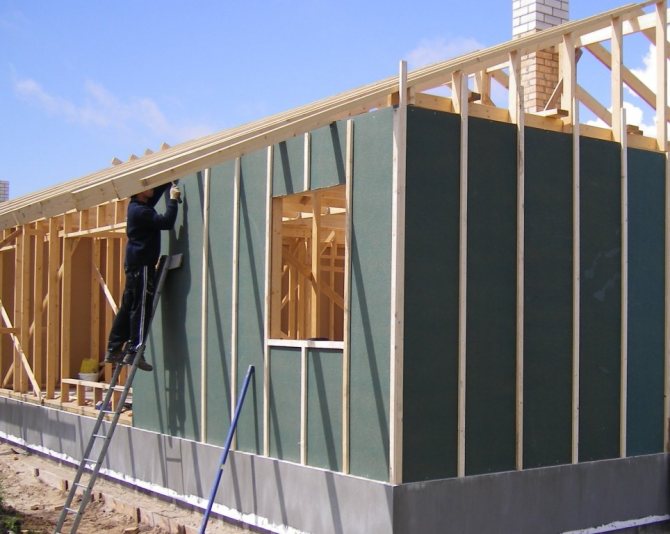

Types of materials
What kind of windscreen to choose for a frame house? To answer this question, you should carefully study your options. Here is a list of the most common ones:
- Izospan is a vapor and moisture protective film. The nonwoven fabric is created according to modern standards and is durable. Izospan, used for windproofing walls, is presented in several versions. Depending on the type, they have a different number of layers. The degree of possible membrane tension also varies. Wide temperature range of use allows the material to be used in any region of the country. The membrane does not emit toxic fumes when heated.
- Wood fiber boards - additionally soundproof the building. The flexible material adheres tightly to the walls, preventing them from being saturated with moisture. The pores in the structure of the tree lead the condensate to the outside, preventing its accumulation. To keep the slabs themselves dry, they are covered with paraffin on all sides.
- OSB-slab strengthens the building frame. The material has low vapor permeability, therefore, in this case, it is necessary to have a vapor barrier using a special film. Facade types of drywall. They are made from natural ingredients, therefore they are environmentally friendly. Drywall is resistant to sudden changes in temperature, fireproof and vapor permeable. It is easy to cut and assemble. The material has a long service life.
- Fiberboard boards are a mixture of cement, wood shavings and liquid glass. The insulation is characterized by environmental friendliness, a high degree of thermal insulation and sound absorption. Fiberboard is not afraid of moisture or fire. Drying after getting wet, the plate returns to its original state. Fiberboard is lightweight, so it is easy to saw and install.
- Extruded polystyrene EPS boards are resistant to water, chemicals and decay. During the entire period of operation, they do not change shape and do not shrink. When used, a rigid base is obtained that strengthens the overall structure of the wall.


Brand windscreen
- ROCKWOOL is a vapor-permeable membrane from a well-known brand. The price of a roll of 70 m2 is about 1000 ... 1200 rubles. Used in professional construction.
- Ondutis is a spin-off from the renowned manufacturer Ondulin. The classic (easiest) version of wind protection - retail is offered at 600 rubles per roll for 35m2 (all prices for February 2020). Diffusion membranes for walls from this manufacturer - about 4000 rubles / roll. Today it is actively advertised for promotion on the market - the brand is relatively new.
- Wigofol is a relatively inexpensive Polish brand. Plain nonwoven windscreens. The price starts from 500 ... 600 rubles. per roll. More applicable to small buildings.
- TechnoNIKOL is a well-known Russian brand. Provides films similar in price and quality to imported manufacturers.
- The Izospan brand is one of the oldest manufacturers of waterproofing materials in the Russian Federation. The cost of membranes is about 2300 rubles. per roll.
- Elite films and membranes are presented by European manufacturers. The price can jump over the figure of 10 thousand rubles per roll. But they guarantee the quality of the products. If you need real indicators of fire resistance - purchase products from this category.
Unnamed windproof films produced in other countries (and even "membranes") can be found below 500 rubles / roll. We do not recommend purchasing - no one will return the money spent in vain.
- Wall kit
Windscreen for the walls of a wooden house
Houses with wooden walls suffer more from moisture than others. The tree is constantly in motion under the influence of temperature. The most destructive periods are weather changes. Therefore, the owners of wooden buildings are sheathed with an additional layer of cladding.
But he is not a panacea either. Wooden walls, if not properly clad, can rot faster than you expect.Reasons: lack of ventilation, more comfortable conditions for organisms destroying wood (bacteria, mold, insects), constant dampness can eat walls two to three times faster than operating without cladding. Therefore, in this case, the use of wind protection is mandatory.
It is recommended not to economize and install diffusion membranes. This approach will allow you not to look under the cladding of a wooden house for at least 10 years.
How to properly lay sheet windscreen
If we are talking about the most popular frame construction today, then the correct sequence of wall layers should be adhered to. For example, after the finishing material inside the house, there should be a vapor barrier and insulation. After them there is a crate for the ventilation gap, and only then layers of wind protection and facade decoration.


Helpful! It is worth clarifying that some materials for wind insulation also have vapor permeability and can even be used as additional insulation. In this case, some layers of the wall can be discarded.
The general algorithm for installing a sheet windscreen is as follows:
- First you need to make sure that all surfaces are dry. The same goes for impregnations.
- Then a complete installation of thermal insulation is carried out. If mineral wool sheets are used, it is important to ensure that they fit snugly together.
- At the next stage, the sheets of windscreen are cut so that they are installed vertically (in height). You can also mount it horizontally, but this is not very convenient.
- The sheets should be laid with the rough side down (if any). This will greatly simplify subsequent finishing work.
- Sheets are fastened with dowels (it is recommended to choose those with larger hats). As a rule, 1 "square" requires at least 5 fasteners.
Of course, each specific material has its own nuances. However, regardless of whether rolled material or sheet material is chosen, novice builders often make a number of mistakes.
